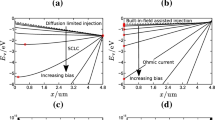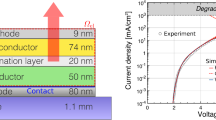Abstract
At cryogenic temperatures the electron–hole plasma in semiconductors becomes strongly degenerate, leading to very sharp internal layers, extreme depletion in intrinsic domains and strong nonlinear diffusion. As a result, the numerical simulation of the drift–diffusion system suffers from serious convergence issues using standard methods. We consider a one-dimensional p-i-n diode to illustrate these problems and present a simple temperature-embedding scheme to enable the numerical simulation at cryogenic temperatures. The method is suitable for forward-biased devices as they appear e.g. in optoelectronic applications. Moreover, the method can be applied to wide band gap semiconductors where similar numerical issues occur already at room temperature.




Similar content being viewed by others
References
Akturk, A., Allnutt, J., Dilli, Z., Goldsman, N., Peckerar, M.: Device modeling at cryogenic temperatures: effects of incomplete ionization. IEEE Trans. Electron Device 54(11), 2984–2990 (2007)
Bessemoulin-Chatard, M.: A finite volume scheme for convection–diffusion equations with nonlinear diffusion derived from the Scharfetter–Gummel scheme. Numer. Math. 121, 637–670 (2012)
Cressler, J.D., Mantooth, H.A.: Extreme Environment Electronics. CRC Press, Boca Raton (2012)
Davis, T.A.: Algorithm 832: UMFPACK V4.3—an unsymmetric-pattern multifrontal method. ACM Trans. Math. Softw. 30, 196–199 (2004)
Farrell, P., Rotundo, N., Doan, D.H., Kantner, M., Fuhrmann, J., Koprucki, T.: Numerical methods for drift–diffusion models. WIAS Preprint 2263 (2016). In: Piprek, J. (ed.) Handbook of Optoelectronic Device Modeling and Simulation. Taylor and Francis, London (2017) (To appear)
Hager, W.W.: Condition estimates. SIAM J. Sci. Stat. Comput. 5, 311–316 (1984)
Jüngel, A.: Qualitative behaviour of solutions of a degenerate nonlinear drift–diffusion model for semiconductors. Math. Model Methods Appl. Sci. 5(4), 497–518 (1995)
Koprucki, T., Rotundo, N., Farrell, P., Doan, D.H., Fuhrmann, J.: On thermodynamic consistency of a Scharfetter–Gummel scheme based on a modified thermal voltage for drift–diffusion equations with diffusion enhancement. Opt. Quantum Electron. 47(6), 1327–1332 (2014)
Mott, N.F.: Metal–Insulator Transitions. Taylor and Francis, London (1974)
Patterson, R.L., Hammoud, A., Elbuluk, M.: Assessment of electronics for cryogenic space exploration missions. Cryogenics 46, 231–236 (2006)
Richey, D.M., Cressler, J.D., Jaeger, R.C.: Numerical simulation of SiGe HBT’s at cryogenic temperatures. J. Phys. IV France 04(C6), C6-127–C6-32 (1994)
Richter, H., Greiner-Bär, M., Pavlov, S.G., Semenov, A.D., Wienold, M., Schrottke, L., Giehler, M., Hey, R., Grahn, H.T., Hübers, H.-W.: A compact, continuous-wave terahertz source based on a quantum-cascade laser and a miniature cryocooler. Opt. Express 18(10), 10179 (2010)
Schlehahn, A., Thoma, A., Munnelly, P., Kamp, M., Höfling, S., Heindel, T., Schneider, C., Reitzenstein, S.: An electrically driven cavity-enhanced source of indistinguishable photons with 61% overall efficiency. APL Photonics 1, 011301 (2016)
Selberherr, S.: Analysis and Simulation of Semiconductor Devices. Springer, Wien (1984)
Selberherr, S.: Low temperature MOS device modeling. In: Proceedings of the 172nd Meeting of the Electrochemical Society, vol. 88-9, pp. 70–86. Honolulu (1987)
Shah, P., Mitin, V., Grupen, M., Song, G.H., Hess, K.: Numerical simulation of wide band-gap AlGaN/InGaN light-emitting diodes for output power characteristics and emission spectra. J. Appl. Phys. 79, 2755 (1996)
Acknowledgements
This work has been supported by the Deutsche Forschungsgemeinschaft (DFG) within the collaborative research center 787 Semiconductor Nanophotonics. The authors would like to thank Jürgen Fuhrmann for useful discussions and one of the reviewers for encouraging us to extend our considerations to wide band gap semiconductors.
Author information
Authors and Affiliations
Corresponding author
Additional information
This article is part of the Topical Collection on Numerical Simulation of Optoelectronic Devices, NUSOD’ 15.
Guest edited by Julien Javaloyes, Weida Hu, Slawek Sujecki and Yuh-Renn Wu.
Rights and permissions
About this article
Cite this article
Kantner, M., Koprucki, T. Numerical simulation of carrier transport in semiconductor devices at cryogenic temperatures. Opt Quant Electron 48, 543 (2016). https://doi.org/10.1007/s11082-016-0817-2
Received:
Accepted:
Published:
DOI: https://doi.org/10.1007/s11082-016-0817-2




